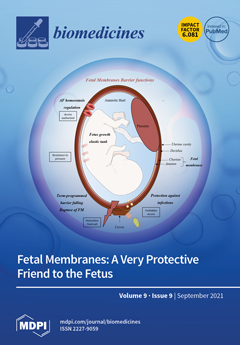Neurotransmission and cognitive dysfunctions have been linked to old age disorders including Alzheimer’s disease (AD). Aluminium is a known neurotoxic metal, whereas
d-galactose (
d-gal) has been established as a senescence agent. WIN55,212-2 (WIN), is a potent cannabinoid agonist which partially
[...] Read more.
Neurotransmission and cognitive dysfunctions have been linked to old age disorders including Alzheimer’s disease (AD). Aluminium is a known neurotoxic metal, whereas
d-galactose (
d-gal) has been established as a senescence agent. WIN55,212-2 (WIN), is a potent cannabinoid agonist which partially restores neurogenesis in aged rats. The current study aimed to explore the therapeutic potentials of WIN on Aluminium chloride (AlCl
3) and
d-gal-induced rat models with cognitive dysfunction. Healthy male albino Wistar rats weighing between 200–250 g were injected with
d-gal 60 mg/kg intra peritoneally (i.p), while AlCl
3 (200 mg/kg) was orally administered once daily for 10 consecutive weeks. Subsequently, from weeks 8–11 rats were co-administered with WIN (0.5, 1 and 2 mg/kg/day) and donepezil 1 mg/kg. The cognitive functions of the rats were assessed with a Morris water maze (MWM). Furthermore, oxidative stress biomarkers; malondialdehyde (MDA), superoxide dismutase (SOD), glutathione (GSH) and neurogenesis markers: Nestin and glial fibrillary acidic protein (GFAP) were also evaluated, as well as the histology of the hippocampus. The results revealed that rats exposed to AlCl
3 and
d-gal alone showed cognitive impairments and marked neuronal loss (
p < 0.05) in their hippocampal conus ammonis 1 (CA1). Additionally, a significant decrease in the expressions of GFAP and Nestin was also observed, including increased levels of MDA and decreased levels of SOD and GSH. However, administration of WIN irrespective of the doses given reversed the cognitive impairments and the associated biochemical derangements. As there were increases in the levels SOD, GSH, Nestin and GFAP (
p < 0.05), while a significant decrease in the levels of MDA was observed, besides attenuation of the aberrant cytoarchitecture of the rat’s hippocampi. The biochemical profiles of the WIN-treated rats were normal. Thus, these findings offer possible scientific evidence of WIN being an effective candidate in the treatment of AD-related cognitive deficits.
Full article






